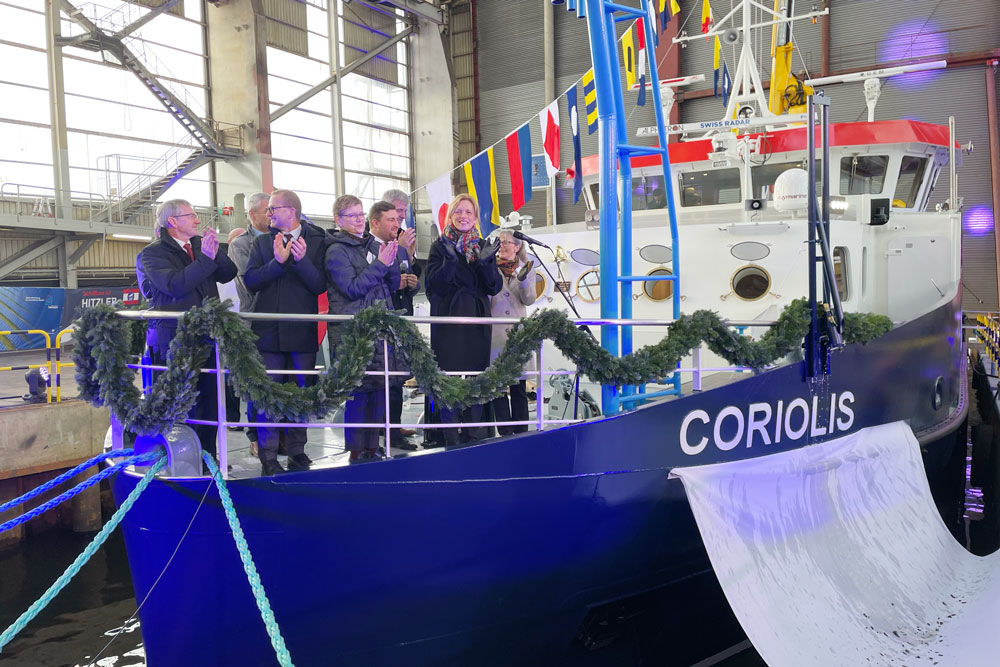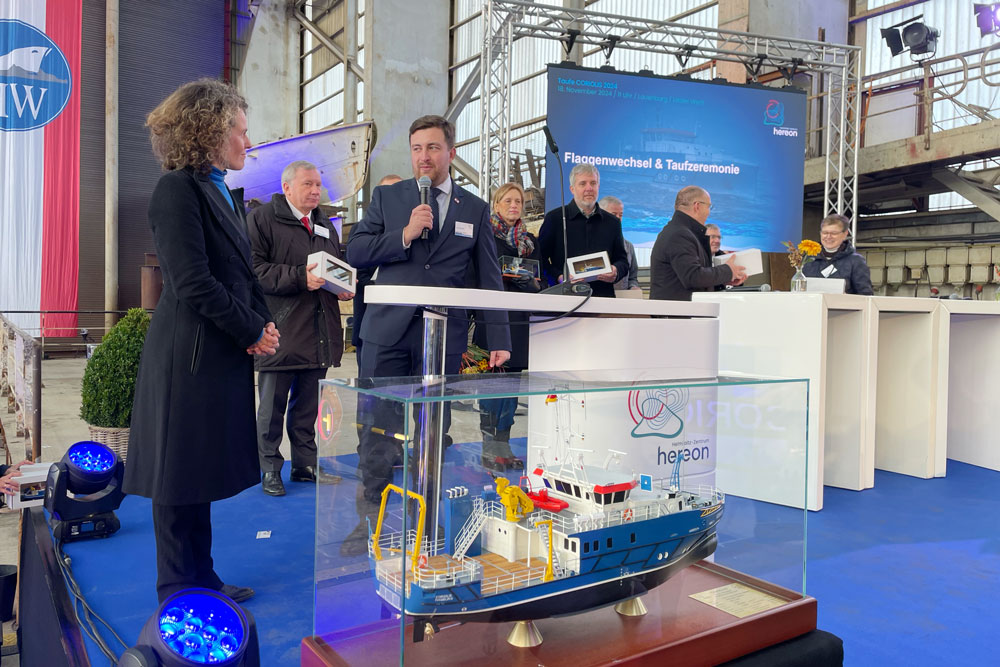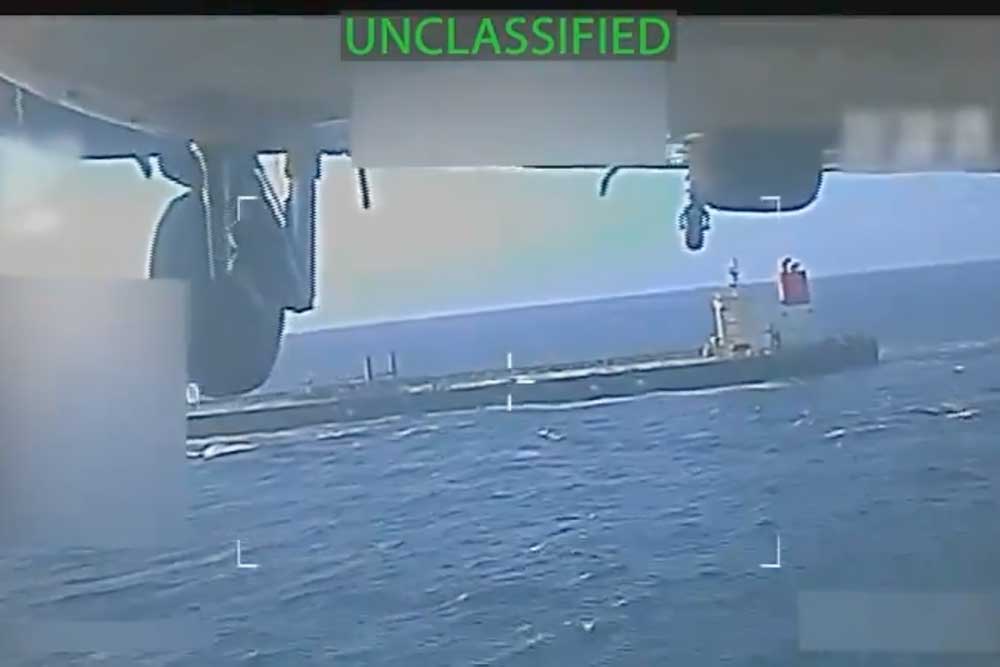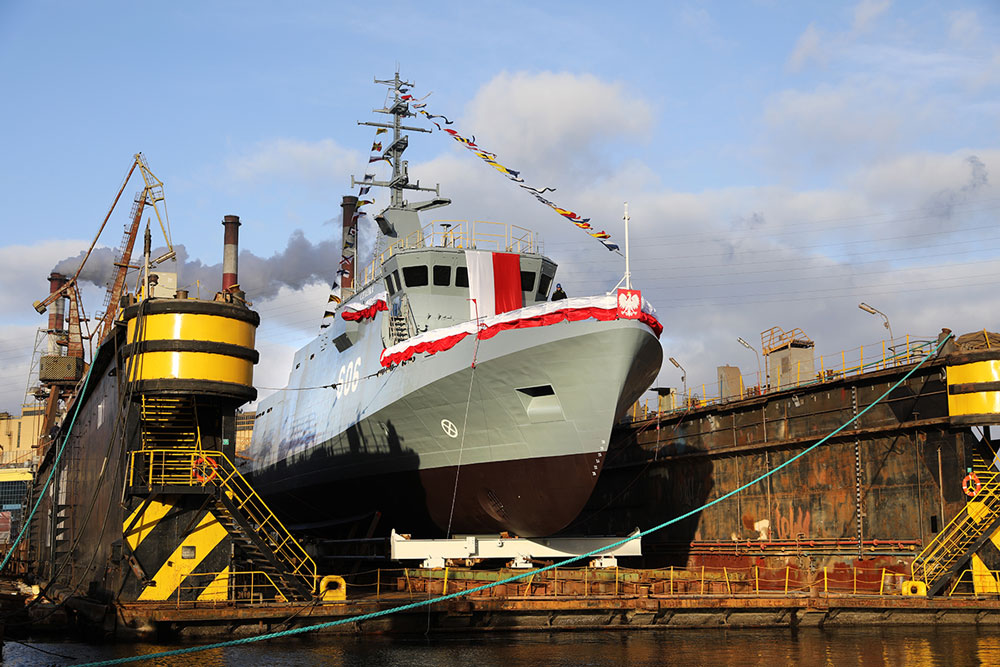The research vessel “Coriolis” was christened at the Hitzler shipyard. After just one and a half years of construction, the newbuilding was handed over to the client, the Helmholtz Institute Hereon.
“It is a special ship among special ships,” said shipyard manager Marek Klimenko, describing the “Coriolis” at its christening. He thanked the client Hereon for “allowing us to build this beautiful ship”. A wide variety of ships have already been built in the halls of the Hitzler shipyard, from supply vessels to icebreakers and tugs. “The range of our possibilities is almost endless. Nevertheless, this ship is something special,” said Marek Klimenko and then listed the technological innovations of the research vessel. “In terms of technology and integration, this ship is one of the heavyweights,” emphasised the shipyard boss in his welcoming address.
Kai Klimenko, the Managing Director of the shipyard, like his father, also spoke about this special project. Construction took just under three years, including the project phase. Around 500 people worked directly on this ship. Kai Klimenko thanked everyone involved: “Without you, it would not have been possible to create this ship,” said the Managing Director.
Kai Klimenko also wanted to highlight one person in particular: his father. He is a brilliant ship engineer and has put his heart and soul into this project. “Without him, we wouldn’t be standing here today at this christening,” says Kai Klimenko.

Three laboratories for the Hereon researchers
The new research vessel is special because it was tailored to the specific needs of the Hereon scientists. They were involved in the planning right from the start. The result is a ship with three laboratories on board: a wet laboratory, an electrical laboratory and a laboratory for hydrogen research. They are all located in an area of around 47 m2.
On the other hand, the “Coriolis ” is special because the technologies that are to be researched on board are also used there. This means that the “Coriolis” will run on fuel cells for up to five hours in future. However, these will not use “conventional” hydrogen to generate energy, but so-called metal hydrides – a type of powdered hydrogen.
The ship also has a hybrid propulsion system consisting of batteries and diesel engines. To reduce its environmental impact, the NOx emissions are cleaned with a special membrane filter.
Around 400 guests celebrate with Hitzler Werft
And because this ship is so special, over 400 guests attended the christening at the Hitzler shipyard. In addition to the Federal Government’s Maritime Coordinator, Dieter Janecek, and his predecessor Norbert Brackmann, numerous other guests from the worlds of politics and research gathered at the Lauenburg shipyard. The godmother was Karin Prien, the Minister of Education of Schleswig-Holstein.

Hydrogen system on board
The “Coriolis” will be equipped with a federally funded hydrogen plant to generate electricity. The funding notification for €560,000 was sent by the project sponsor, the Federal Agency for Administrative Services, at the beginning of the year. The money comes from the funding pot for the German government’s mobility and fuel strategy (MKS).
The project, which costs a total of €1.4m, focuses on the procurement of the fuel cell, the bunker station, the metal hydride tank and the control and regulation of the hydrogen storage system.
Hydrogen is stored in metal hydride tanks
The metal hydride tank for hydrogen storage was developed by Hereon and researched at its Institute for Hydrogen Technology. According to Hereon, the safe and compact design has the advantage that hydrogen can be stored at moderate pressure (50 bar) and temperature conditions (operating temperatures in the tank -30 to a good 50 °C). In addition, it is chemically bound in the tank, which prevents an explosive release in the event of a tank accident.
According to the information provided, the on-board power system will supply the “Coriolis” with power both during laytime and during the measurement campaigns in the North and Baltic Seas. In addition, the electric position-steering propeller at the stern and the bow thruster could also draw power for short periods.
For research purposes, a 45 kW diesel generator will also be combined with a membrane module developed by Hereon. This allows harmful NOx emissions to be virtually eliminated. The drive concept has a redundant design. The fuel cell, battery and generators can therefore be combined with each other. Electric traction motors provide the propulsion on the “Coriolis”.

“Coriolis” will be used near the coast and rivers
After delivery at the beginning of next year, the “Coriolis” will be deployed on the North Sea and Baltic Sea as well as on the rivers Ems, Weser, and Elbe. The results from subsequent operations will be used to optimise the hydrogen systems and simplify the retrofitting of other seagoing and inland waterway vessels.
The total costs for the “Coriolis” amount to €18m and the federal government will bear the costs.
Technical specifications of the “Coriolis”
- Length/width/draft: 29.90 m / 8.00 m / 1.6 m
- Crew/ scientists: 2 (+1) / 12
- Laboratory area/ working deck area: 47 m²/ 70 m²
- Operating range: Coastal cruising International 100 nm
- Speed: max. 12 kn
- Engine power: 750 kW
- Operating days/year: approx. 225
- Fuel cell: 100 kW
- Metal hydride tank/hydrogen storage: 5 t (30 kg)
- Classification: Bureau Veritas














